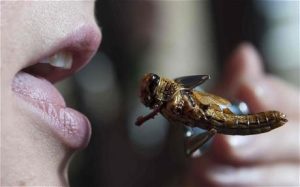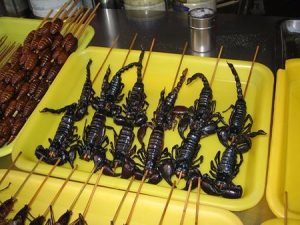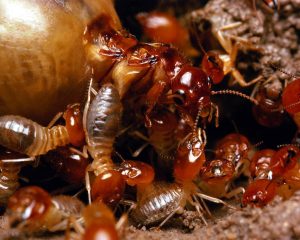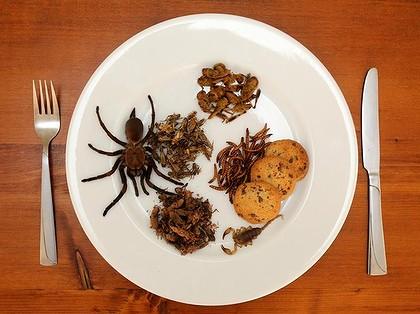Click Here To Join Our Telegram Channel for FREE daily tutorials!
Bugs may not seem like the ideal meal to us, Americans, but eating insects is a common practice in Asian and African countries and even in Australia. And while we find it gross to cook bugs and eat them, people from other parts of the world have put these prejudices aside and are now eating insects for their highly nutritional value.
For example, caterpillars have more protein than an equal quantity of minced beef. Even more so, a study shows that some insects and larvae are much more nutritious than any of our regular foods:
While beef provides 200 – 300 calories per 100 grams (depending on the fat level), live termites provide about 350 calories per 100 grams. Moth larvae are good eats as well, providing nearly 265 calories per 100 Grams (and they’re also ideal if you want a massive protein intake fast, as they’re about 63% protein).
Sure, now you might be thinking that beef is much more delicious than caterpillars or moth larvae, but you’d be surprised to hear how wrong you’d be. Most bugs are very tasty, especially when cooked. There are bugs that taste like apple pie, lemongrass or cinnamon.
So if at some point you’re forced to improvise a meal from whatever you find crawling on the ground, don’t hesitate just because you’ve never eaten bugs before. Try to get rid of your prejudices and see it as a brand new experience. It will not be half bad, I assure you.
So here’s the alphabetical list of bugs you can eat to stay alive and fit:
1. Agave worm
 source: www.ianchadwick.com
source: www.ianchadwick.com
The agave worm is also known as the Mezcal worm, because in Mexico, you can find them in Mezcal bottles (a drink similar to tequila).The producers are said to add them to the bottles to prove the alcohol is authentic, but also to attract customers who want to try something new. There are many who buy Mezcal just to eat the worm inside. And it’s great that they do — besides the adrenaline rush, they also get a great protein intake.
2. Ant
 source: http://buzzle.com
source: http://buzzle.com
There are a few varieties of ants you can eat simply for their delicious taste: leafcutter ants (that taste a bit like bacon, with a nutty flavor when raw and like popcorn when they’re fried), lemon ants (that taste like lemon, of course) and honeypot ants (that have a slightly sour taste and are best eaten raw)
3. Bamboo worm
 source: lavalamp224.blogspot.com
source: lavalamp224.blogspot.com
In Thailand, you can eat an entire meal made of fried bamboo worms. They may not look appealing, but they taste delicious when cooked right and they’re much healthier than meat while providing a load of essential nutrients.
4. Bee
 source: www.ireallylikefood.com
source: www.ireallylikefood.com
Whether you eat bee larvae or adult bees, prepare to blown away by their surprising tastiness. You can roast them, dip them in butter and fry them or make bee cookies (just like in the image above). No matter which variant you choose, you’ll be surprised to feel the taste of bacon and sauteed mushrooms in your mouth.Judging by what they eat all day long — pollen and honey — you might think they taste like candy. Which wouldn’t have been half bad, either.
Warning: be extra careful not to get stung during the process!
5. Beetles
 source: www.allaboutbeetles.co.uk
source: www.allaboutbeetles.co.uk
Globally, beetles are one of the most consumed insects are with 31 percent of the population chowing down on these six-legged bugs on a regular basis. Despite the icky-sounding name, dung beetles (pictured above) are often eaten fried and are quite tasty.
6. Caterpillars
 source: aultparksunrise.com
source: aultparksunrise.com
According to the FAO, 18 percent of the world enjoys finding caterpillars on its dinner plate, especially in regions where it’s difficult to get your hands on other sources of protein. They’re served boiled, dried or fried in oil.
7. Centipede
 source: www.china-memo.com
source: www.china-memo.com
In China, roasted centipedes stuck on wooden sticks and displayed on metal trays are simply part of the “street food”. Their crunchy texture and savory taste have attracted many to give cooked centipedes a try, but you must be very careful: if you want to catch and cook your own centipedes, you’ve got to be extremely careful. If you get bitten, you might get a painful swelling that can last several days. So make sure you take every protection measure it takes to kill the insect without getting hurt.
8. Cicada
 source: www.nbcnews.com
source: www.nbcnews.com
Even though they don’t look like it, cicadas are described as “soft, juicy and tender”, a real delight for the ones brave enough to ignore the unappealing looks. You can either cook them or eat them raw (although, as a general rule, it’s best to cook any bug you plan on eating because heat kills a lot of germs).
9. Cockroach
 source: jamaica-gleaner.com
source: jamaica-gleaner.com
Who would’ve thought cockroaches can taste like chicken? The ones who’ve eaten these bugs said the taste is very much like “greasy chicken” (only cockroaches are much healthier). Just make sure you cook them properly, at a high temperature, so you kill any germs they may carry with them.
Don’t worry, there are plenty of ways to cook them: you can toast, fry, boil or sautee them, depending on the resources you’ve got on hand.
10. Cricket
 source: theweek.com
source: theweek.com
People all over the world eat crickets. There are dozens of recipes you can try, from pastes to cookies and cakes, soups and sauces… or the simple roasted cricket that you can see on the streets of Mexico, Thailand or Cambodia.
11. Dragonfly
 source: thedragonflywoman.com
source: thedragonflywoman.com
To catch a dragonfly, you can use this common technique used in Indonesia: just dip a reed in sticky palm sap and wave it through the air. After you catch enough of them to put together a meal, you can boil them or fry them.
12. Dung Beetle
 source: www.flickr.com
source: www.flickr.com
Well, that doesn’t sound very appealing, does it? No one in their right mind would like to eat something that has to do with dung. But here’s the thing: these bugs have a delicious taste, according to the ones who’ve eaten these little nutritional bombs.
So if you’re forced to eat these bugs, don’t hesitate and start boiling or frying them, they’ll taste great! Just don’t eat them raw, because they may carry bacteria that you don’t want to ingest.
13. Earthworm
 source: www.ehow.com
source: www.ehow.com
Here’s what you didn’t know about earthworms: they’re very high in protein and iron, therefore healthy and full. In some areas of Venezuela, these properties have long been discovered and ever since earthworms have been included in meals or eaten raw.
14. Fly pupae
 source: haveylab.hort.wisc.edu
source: haveylab.hort.wisc.edu
The taste of fly pupae may not make you go over the moon, as they’ve been described as “sort of like blood pudding” (David Gracer of Small Stock Foods), due to the high level of iron. However, the health benefits should convince you to get past the taste and enjoy the low-carb, supernutritious meal that will give you strength and some extra energy.
15. Grasshopper
 source: indianapublicmedia.org
source: indianapublicmedia.org
If you ever go to Mexico (in case you haven’t been there by now), don’t be surprised if you’re offered chapulines (roasted grasshoppers with a touch of chili and lime). Besides the fact that they’re delicious, they’re also high in calcium and protein.
16. Hornworm
 source: www.furneysnursery.com
source: www.furneysnursery.com
The green thing crawling in the above is a hornworm. A tomato hornworm. These insects are like looters for your garden, so you’ll actually do your tomatoes a favor by cooking a few of them. They’re said to taste like shrimp and green tomatoes when fried, not exactly what you’d expect from a crawley.
17. Jumiles
 source: www.cottoncrc.org.au
source: www.cottoncrc.org.au
You may know these insects under the name of stink bugs. I’m pretty sure you’ll find them even less appealing now, but you should know they’re high in B vitamins and they taste like cinnamon, so maybe this will make you change your mind about eating them when there’s nothing else around.
Also, they may have analgesic properties. They’re not as efficient as a painkiller, but when you’ve got nothing else on hand, it’s good to know some worst-case-scenario alternatives.
A heads-up: usually, stink bugs survive the cooking process, so they’ll probably still be alive when you think they’re dead. Don’t freak out, it’s not something you’ve done wrong, they’re just very resistant.
And an extra tip: it’s better to get rid of the stink before you start cooking them and to do that you need to keep them in a jar filled with water for a few hours (or even let them soak over night).
18. June bug
 source: food52.com
source: food52.com
I bet you’ve never thought of replacing popcorn with June bugs. But Native Americans used to eat them roasted over coals, as a snack, just like we eat popcorn. They’re filled with nutrients and have a crunchy texture that you’ll find interesting (the least).
19. Leech
 source: www.critterzone.com
source: www.critterzone.com
If you’ve got a pond or a lake somewhere near you, then you’ve got yourself a meal. No, I don’t mean (just) fish, I’m talking about leeches. They’re quite easy to catch and cook, so if you’re extremely hungry, you’ll be glad to know you’ll be eating a nutritious meal in no time.
The best way to cook leeches is to grind them and mix them into a paste that you can fry a little, for better taste.
20. Locust
 source: www.telegraph.co.uk
source: www.telegraph.co.uk
Locusts have very similar taste and texture as grasshoppers or crickets. You can roast, fry or boil them or you can get creative and mix them in a soup or a sauce (after you chop or grind them).
21. Mopane worm
 source: www.usatoday.com
source: www.usatoday.com
This fat worm is eaten mostly in Southern Africa and it’s considered a delicacy. In fact, when it’s “season”, their price goes through the roof (they get more expensive than beef sometimes).
You can eat it fried or dried, it’s said to be delicious either way. And yes, it’s so filled with nutrients, beef has nothing on it.
22. Mealworm
 source: wildernesschilde.blogspot.com
source: wildernesschilde.blogspot.com
It’s very simple: wherever you find a meal, you’ll also find mealworms (and mealworm beetles). All you need to do is pick a jarful of this crawlies and then decide how you want to serve them: boiled, roasted, fried or sauteed. People who’ve tasted cooked mealworms said they taste a lot like shrimp, with a slightly nutty flavor.
23. Midge fly
 source: www.fishingfury.com
source: www.fishingfury.com
It’s quite hard to catch enough midge flies to put together a meal, but if you can’t find anything else around, you’ll just have to do with these. The good part is that you can fix them with other ingredients to add protein to your meal. For example, in East Africa, midge flies are an ingredient in the famous Kunga Cake.
24. Scorpions
 source: blog.asiahotels.com
source: blog.asiahotels.com
Yes, that’s a tray full of fried scorpions. In China, you’ll see a lot of those and they’re said to be crunchy and delicious. In fact, they’re so tasty, some shops sell them covered in chocolate or locked in lollipops.
However, I wouldn’t recommend you to go hunting for scorpions. If you get the chance to eat a scorpion that’s already cooked, don’t hesitate. But don’t try to kill and cook one yourself, they’re very dangerous.
25. Tarantulas
 source: www.alwaysfoodie.com
source: www.alwaysfoodie.com
The same rule applies here as with scorpions: tarantulas can be poisonous (unless they’re bought from a pet store), so don’t try to catch and cook one all by yourself.
However, you may find yourself in the situation where cooked tarantulas are the only meal you can eat (if you’re planning a trip to Cambodia you should take this into consideration). In this case, try to leave your prejudices aside and enjoy this meal, because tarantulas have a mix of tastes (crab and nuts altogether) and textures (from crunchy to juicy) that will definitely surprise you. In the good way.
26. Termite
 source: emergingworld.org
source: emergingworld.org
Have you ever seen a documentary on Discovery Channel or Animal Planet where a monkey sits on top of a termite nest and uses a stick to catch them and eat them easier? Well, monkeys know what they’re doing.
The stick method has proved the most effective so far in catching the largest number of termites at once and it’s also extremely simple: you take a stick, poke it into the nest by twisting it, then pull it out and eat the termites on it. If you don’t want to eat them raw, you can put lock them in a jar until you can cook them.
27. Wasp
 source: gardenofeaden.blogspot.com
source: gardenofeaden.blogspot.com
If you want to add some nutrients to your meal, you can cook wasps with rice, for example. This is one of Emperor Hirohito’s (Japan) favorite meals. So if an emperor can eat wasps for lunch, so can you. You can cook them any way you want, just be extra careful about the stinging.
28. Walking stick
 source: www.comfortcookadventures.com
source: www.comfortcookadventures.com
When you catch a walking stick, you’ve got a meal and a tool to catch your next meal, as well. How is that? People in Asia eat the body of the insect and use their legs as fishhooks.
Unfortunately, walking sticks don’t have a bacon, nutty or buttery taste like most of the insects on the list. Just think of them more as a side dish, since they taste kind of leafy.
29. Waxworm
 source: www.fiddlecreekfarms.com
source: www.fiddlecreekfarms.com
These are larvae of the wax moth — a parasite of beehives. They may not look like something you’d eat on a daily basis, but waxworms are not only tasty but also high in essential fatty acids.Plus, they maintain their fresh pine nut flavor whether they’re roasted, fried or sauteed.
30. Witchetty Grubs
 source: tasteaustralia.biz
source: tasteaustralia.biz
There are restaurants in Australia that serve these delicacies roasted on coals. They’re high in protein and you can eat them pretty much any way you please: raw, roasted, fried… They taste great and are just as full as beef.
Now that you know what bugs you’re allowed to eat, you should know what bugs never to catch and cook by yourself, as well. There are 6 general rules you should follow if you don’t want your meal to turn into a nightmare.
You should keep in mind that not all of these rules forbid you to eat these bugs. Some of them simply advise you to avoid catching and cooking dangerous insects yourself. It’s best not to go hunting for scorpions or try to cook a tarantula. It’s safer to stick to harmless bugs and avoid the following categories of insects:
#1: Don’t eat bugs that could carry diseases
Insects that are known to carry diseases, such as mosquitoes, flies, and ticks, should not be eaten. Besides, it’s not that easy to catch a sufficient number of flies or mosquitoes to provide enough proteins and satisfy your hunger.
#2: Don’t eat poisonous insects
This one needs no explanation, as the reasons are quite clear. However, there is an exception to this rule: if the bug is already killed and properly cooked, you could give it a try and eat spiders or scorpions.
#3: Don’t eat bugs that are already dead
You can’t know the reason why they died, so unless you want to risk your family’s health or even life, don’t eat or cook dead insects. No matter how hungry you are, make an extra effort and look for live bugs. If you found a dead one, you’ll find live ones in its proximity, as well.
#4: Don’t eat bugs that bite or sting
There are a few exceptions to this rule (such as bees, wasps, and centipedes) if they’re already cooked. But as a general rule, don’t try to catch and cook insects that can harm you.
If it bites or stings, move on and look for something safer. There are 1,400 edible insects, surely you’ll find something that won’t attack you when least expected.
#5: Don’t eat bugs that smell really badly
Usually, bugs give out foul odors as a warning to predators: keep away, I’m dangerous. So you, as a clever predator, should know better than to attack a badly smelling bug, cook it and eat it.
However, there is a species of insects that made the edible bugs list: the stinkbug. I’ve already told you how you can get rid of the smell, so if there’s nothing else there for you to eat, go ahead and cook these insects.
#6: Don’t eat brightly-colored bugs
The reason behind this rule is the same as for the badly smelling insects. Bright colors often indicate that it’s dangerous to come close, so it’s safer to stay away from bugs that catch your eye with their vivid colors.
Keep these rules in mind and you’ll make your bug-eating experience much better. Now, you don’t have to turn into Bear Grylls overnight, it’s absolutely natural to feel disgusted, but if you’re forced to eat bugs to stay alive, it’s good to remember that people all over the world have been doing this for centuries and not out of necessity, but simply because they taste good and are very healthy.
By Alec Deacon
This Crazy Off Grid Device Literally Makes Drinkable Water From Fresh Air:
According to NASA, the U.S. is expecting a 100-YEAR LONG MEGADROUGHT.
It's already begun. Ask the farmers in California. They know.
Every survivalist knows that water is of critical importance. You NEED an independent water source that you can count on!
As an interesting "survival rehearsal" - imagine that you turned the tap on right now and nothing came out. How long would you last?
But what if there was another water source literally hidden in plain sight. That's right, I'm talking about the atmosphere!
The amazing thing about getting water from the natural moisture in the air... is that it is ALWAYS available.
This gives you real water security!
Learn more about how to tap into "Nature's secret water reservoir" and stay hydrated when TSHTF!
Watch the video:
😳 What Tinnitus Does To Your Brain Cells (And How To Stop It)
After 47 years of studies and countless brain scans done on more than 2,400 tinnitus patients, scientists at the MIT Institute found that in a shocking 96% of cases, tinnitus was actually shrinking their brain cells.
As it turns out, tinnitus and brain health are strongly linked.
Even more interesting: The reason why top army officials are not deaf after decades of hearing machine guns, bombs going off and helicopter noises…
Is because they are using something called "the wire method", a simple protocol inspired by a classified surgery on deaf people from the 1950s...

I Can't Help Showing This Off:
If you haven't heard of Claude Davis yet do yourself a huge favor and watch this video.
One of the smartest guys I ever had the pleasure of meeting, Claude set-up a unique prepping system that changed his life forever.
I already tried it myself and let me tell... you I was completely blown away... His surprising tactics could make your life easier and give you the peace of mind you deserve.
Don't just take my word for it... watch his short video and decide for yourself.

Most People Don't Have The Guts To Try This:
An amazing discovery in an abandoned house in Austin, Texas: A lost book of amazing survival knowledge, believed to have been long vanished to history, has been found in a dusty drawer in the house which belonged to a guy named Claude Davis.
Remember... back in those days, there was no electricity... no refrigerators... no law enforcement... and certainly no grocery store or supermarkets... Some of these exceptional skills are hundreds of years of old and they were learned the hard way by the early pioneers.
>> Click here to find out about them now
We've lost to history so much survival knowledge that we've become clueless compared to what our great grandfathers did or built on a daily basis to sustain their families.
Neighbors said that for the last couple of years Claude has tried to unearth and learn the forgotten ways of our great-grandparents and claimed to have found a secret of gargantuan proportions. A secret that he is about to reveal together with 3 old teachings that will change everything you think you know about preparedness:
>>> Click Here To Watch His Short Video <<<

More Off-Grid And Survival Resources:

What REALLY Happens When You Bury a Shipping Container? (Hint: It's A Bit Crazy...)
Shipping containers are all the rage - but if you are thinking about buying one, you MUST watch this video first:
There's a general belief that if you bury a shipping container you can create an awesome root cellar / storm shelter / survival bunker.
But is a shipping container strong enough to handle the pressure?
Watch the video to see what happens:
What Really Happens When You Bury a Shipping Container? (Click To Watch Video)











Had some termites in Belize.
We went cave tubing and our guide gave us an opporunity to have a termite along the way.
Just one little termite was like an explosion of mint in my mouth!
Heck, on our way back to our hotel we stopped for lunch. Afterwards I asked the guide if there were any “after dinner termites” available 😉
Good way of explaining, and nice piece of writing to take facts
concerning my presentation topic, which i am going
to deliver in college.
It is interesting to consider that a good number of countries, other than the United States, view bugs the way Americans view seafood and other fish. Just a different perspective and knowing what to eat and what not to eat. Nice list, and thank you for sharing the information.